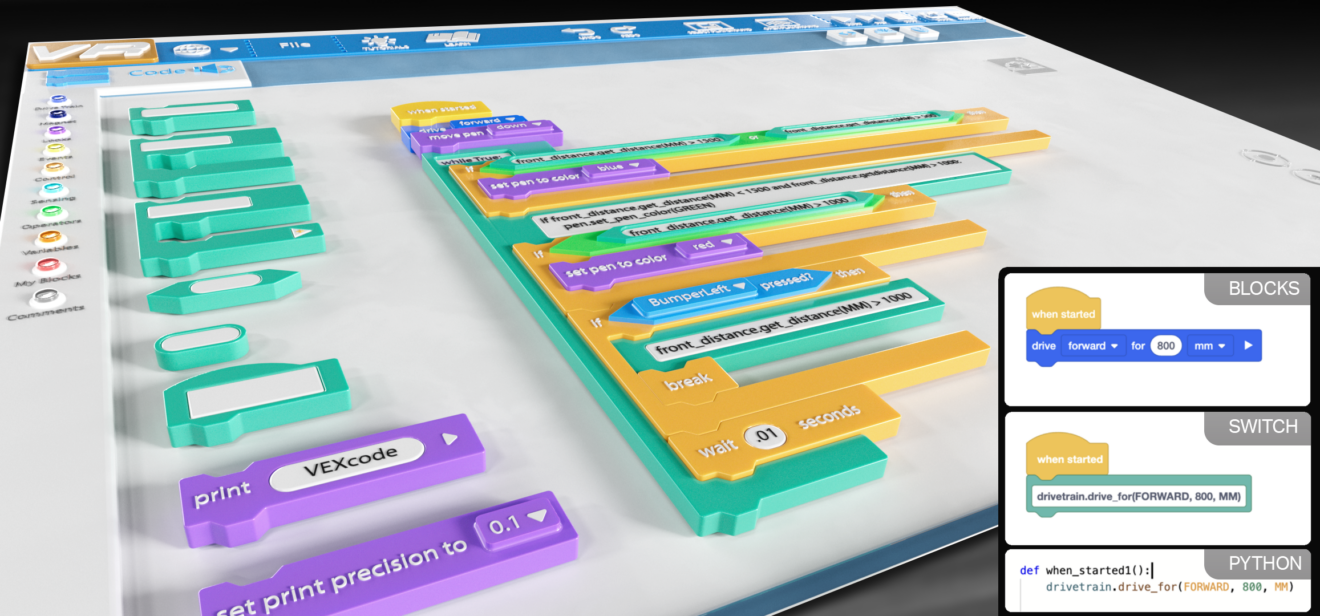This post is sponsored by VEX Robotics
Block-based programming language is visual and versatile, allowing users to explore a wide variety of coding while remaining focused on important concepts of coding and computational thinking.. This makes it a go-to for beginners and ideal for K-12 students. Using intuitive drag-and-drop functions, block-based coding is popular in early robotics and coding classes. While an excellent intro to coding, to go further, and potentially make a career of it, students need to learn text-based coding.
Text-based coding uses a language utilizing brackets, semicolons, equal signs, quotation marks and other symbols. Each character identifier represents a specific purpose. Text-based coding is the real life application and what professionals use. Engaging learners with intuitive block-based systems then scaffolding to text-based coding is key to keeping computer science classes authentic for learners.
Tech solutions ease the transition
Like many languages, teaching computer programming early in the educational journey is ideal. Research shows that learning to code may ultimately aid students’ learning and acquiring of skills in domains other than coding. Block-based programming simplifies the concept of coding and can help students embrace programming instead of shying away from it – but once they understand the basics, it’s time to introduce text-based programming.
This shift from block to text-based coding is now easier than ever with VEXcode VR Switch. This new learning solution provides scaffolding, allowing students to see the code in the block and then type it in themselves. It is a useful tool to help them become proficient with actionable guidance along the way. One helpful feature of this tech is being operational offline, allowing learners to scaffold the process on their own.
“Educational research is clear. In order to teach novice students computer science, the best way to start is with blocks. It is overwhelming to learn syntax, the order of commands as well as the logic of computer science. Computer science and computational thinking is a lot more than just syntax,” explains Jason McKenna, director of global educational strategy at VEX Robotics.
“We want our students to learn sequence, decomposition, loops, conditional statements, and the best way is with blocks so they can focus on the big ideas of computer science.”
In the VEXcode VR Switch Beta, users can convert blocks to Switch Python blocks or use a Switch block to begin typing Python commands immediately. The tech tool is dynamic, evolving based on feedback from educators and students.
“The scaffolding the VEXcode VR Switch offers allows students to see what the code is in the block, and they can then type that inside the block,” said McKenna. “This introduces students to text much easier.”
Block-based programming languages such as Scratch have been designed for students as young as preschoolers, with most geared toward students between 8 and 16. This type of intuitive and exciting tech is not only a stepping stone to a deeper experience in computer science, but leads to a deeper impact for the future of the field. Creating learning opportunities for all young fans of coding improves equity and inclusivity in what has long been perceived as an exclusionary and privileged industry. Starting students early with an engaging system that they can excel at, while mastering concepts to transition to full text-coding, can open doors for the future and lead them on a path to success.
VEX Robotics is the global leader in STEM education, offering the VEX continuum to help students of all abilities find success quickly and also grow their STEM knowledge and competencies. Learn more about how we empower educators to engage and inspire the STEM innovators and problem-solvers of today and tomorrow.
